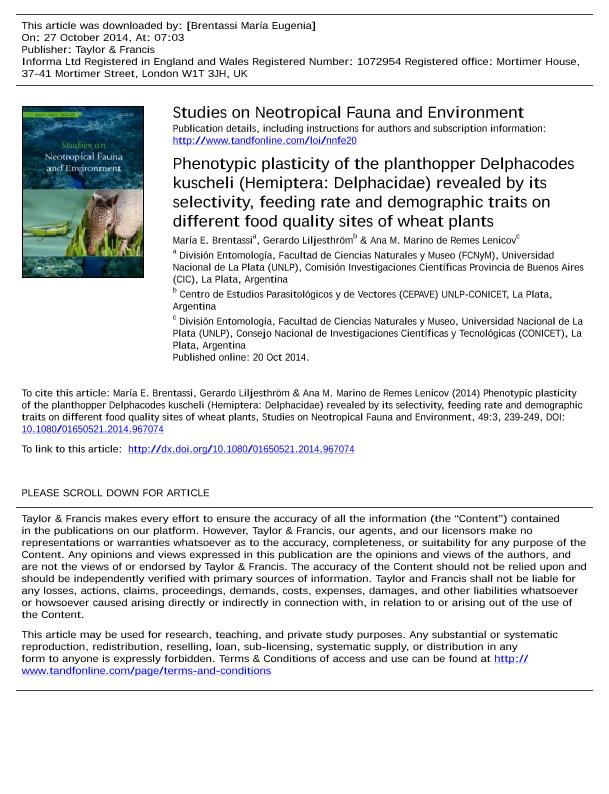Mostrar el registro sencillo del ítem
dc.contributor.author
Brentassi, Maria Eugenia

dc.contributor.author
Liljesthrom, Gerardo Gustavo

dc.contributor.author
Marino, Ana Maria

dc.date.available
2018-01-10T19:06:16Z
dc.date.issued
2014-10
dc.identifier.citation
Marino, Ana Maria; Liljesthrom, Gerardo Gustavo; Brentassi, Maria Eugenia; Phenotypic plasticity of the planthopper Delphacodes kuscheli (Hemiptera: Delphacidae) revealed by its selectivity, feeding rate and demographic traits on different food quality sites of wheat plants; Taylor & Francis Ltd; Studies on Neotropical Fauna and Environment; 49; 3; 10-2014; 239-249
dc.identifier.issn
0165-0521
dc.identifier.uri
http://hdl.handle.net/11336/32873
dc.description.abstract
Delphacodes kuscheli, a phloem sap-sucking planthopper and the main vector of the Mal de Río Cuarto virus (MRCV) of maize in Argentina, was used to analyze phenotypic plasticity in behavior and demographic traits in response to different food quality, without masking the effects of density dependence and within-plant heterogeneity. We evaluated selectivity of nymphs and adults for different sites of wheat plants and, on sites suspected to have different food quality because of the presence/absence of meristems and therefore different nitrogen content, we evaluated pre-imaginal survival, nymphal developmental time, proportion of macropterous morphs, adult longevity and feeding rate. Delphacodes kuscheli showed a positive selection for plant zones suspected to have higher food quality and on them insects developed faster, exhibited higher nymphal survival and adult longevity and produced a lower proportion of macropterous morphs. Also on sites suspected to have lower food quality the number of honeydew droplets excreted per day increased and the mean diameter diminished, suggesting that the planthopper could probe more frequently to compensate for different food quality.
dc.description.abstract
Delphacodes kuscheli, planthopper alimentador de savia y principal vector del Mal de Río Cuarto virus (MRCV) del maíz en Argentina, fue utilizado para analizar la plasticidad fenotípica en el comportamiento y características demográficas en respuesta a una diferente calidad alimenticia, sin los efectos enmascarados denso-dependientes y de la heterogeneidad de la planta. Evaluamos la selectividad de ninfas y adultos por diferentes sitios de las plantas de trigo y, sobre sitios de diferente calidad alimenticia, debido a la presencia-ausencia de meristemas y por lo tanto diferente contenido de nitrógeno, evaluamos la supervivencia pre-imaginal, tiempo de desarrollo ninfal, proporción de morfos macrópteros, longevidad del adulto y tasa de alimentación. Delphacodes kuscheli mostró selección positiva por sitios considerados de mayor calidad alimenticia y sobre ellos los insectos se desarrollaron más rápido, exhibieron una mayor supervivencia ninfal y longevidad del adulto y produjeron una menor proporción de morfos macrópteros. Además sobre sitios considerados de inferior calidad alimenticia el número de gotas de honeydew excretado por día incrementó y el diámetro disminuyó sugiriendo que el planthopper podría probar más frecuentemente para compensar la diferente calidad alimenticia.
dc.format
application/pdf
dc.language.iso
eng
dc.publisher
Taylor & Francis Ltd

dc.rights
info:eu-repo/semantics/openAccess
dc.rights.uri
https://creativecommons.org/licenses/by-nc-sa/2.5/ar/
dc.subject
Foosd Quality
dc.subject
Planthopper
dc.subject
Phenotypic Plasticity
dc.subject
Nitrogen
dc.subject
Mal del Rio Cuarto Virus
dc.subject
Maize
dc.subject.classification
Otras Ciencias Biológicas

dc.subject.classification
Ciencias Biológicas

dc.subject.classification
CIENCIAS NATURALES Y EXACTAS

dc.title
Phenotypic plasticity of the planthopper Delphacodes kuscheli (Hemiptera: Delphacidae) revealed by its selectivity, feeding rate and demographic traits on different food quality sites of wheat plants
dc.type
info:eu-repo/semantics/article
dc.type
info:ar-repo/semantics/artículo
dc.type
info:eu-repo/semantics/publishedVersion
dc.date.updated
2018-01-10T16:52:59Z
dc.journal.volume
49
dc.journal.number
3
dc.journal.pagination
239-249
dc.journal.pais
Reino Unido

dc.journal.ciudad
Londres
dc.description.fil
Fil: Brentassi, Maria Eugenia. Consejo Nacional de Investigaciones Científicas y Técnicas; Argentina. Universidad Nacional de La Plata. Facultad de Ciencias Naturales y Museo. División Entomología; Argentina. Provincia de Buenos Aires. Gobernación. Comisión de Investigaciones Científicas; Argentina
dc.description.fil
Fil: Liljesthrom, Gerardo Gustavo. Consejo Nacional de Investigaciones Científicas y Técnicas. Centro Científico Tecnológico Conicet - La Plata. Centro de Estudios Parasitológicos y de Vectores. Universidad Nacional de La Plata. Facultad de Ciencias Naturales y Museo. Centro de Estudios Parasitológicos y de Vectores; Argentina
dc.description.fil
Fil: Marino, Ana Maria. Consejo Nacional de Investigaciones Científicas y Técnicas; Argentina. Universidad Nacional de La Plata. Facultad de Ciencias Naturales y Museo. División Entomología; Argentina
dc.journal.title
Studies on Neotropical Fauna and Environment

dc.relation.alternativeid
info:eu-repo/semantics/altIdentifier/doi/http://dx.doi.org/10.1080/01650521.2014.967074
dc.relation.alternativeid
info:eu-repo/semantics/altIdentifier/url/http://www.tandfonline.com/doi/abs/10.1080/01650521.2014.967074
Archivos asociados
